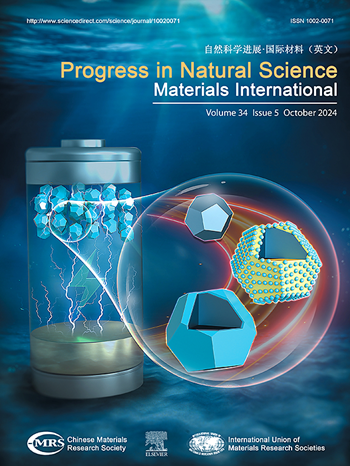Multi-objective optimization for shape memory alloys with large recoverable strain and low hysteresis
IF 7.1
2区 材料科学
Q2 MATERIALS SCIENCE, MULTIDISCIPLINARY
Progress in Natural Science: Materials International
Pub Date : 2025-04-01
DOI:10.1016/j.pnsc.2025.02.004
引用次数: 0
Abstract
Design
of shape memory alloys with large phase transformation strain and low hysteresis is in demand for practical applications that require high output work and high precision. However, this remains challenging due to the competition between these two properties. In this work, we report a method that combines machine learning with multi-objective optimization to assist the rapid design of shape memory alloys. Instead of directly using the predictions from machine learning to guide experiments, this work employs the uncertainty-aware two-objective optimization algorithm to recommend the potential candidates. Such a strategy is beneficial to the case where limited data is available just as the dataset of twenty NiTi-based alloys with hysteresis and phase transformation strain established herein. Key features are screened out from a relatively large feature pool and Gaussian regression models are built for predicting the two properties of unknown alloys. At the end, eight alloys with promise to improve both recoverable strain and hysteresis are recommended, as compared to the alloys in the initial dataset.
大可恢复应变低迟滞形状记忆合金的多目标优化
设计具有大相变应变和低迟滞的形状记忆合金是实际应用中对高输出功和高精度的要求。然而,由于这两个属性之间的竞争,这仍然具有挑战性。在这项工作中,我们报告了一种将机器学习与多目标优化相结合的方法来辅助形状记忆合金的快速设计。这项工作不是直接使用机器学习的预测来指导实验,而是使用不确定性感知的双目标优化算法来推荐潜在的候选对象。这种策略对于数据有限的情况是有利的,就像本文建立的20种镍钛基合金的迟滞和相变应变数据集一样。从相对较大的特征池中筛选出关键特征,并建立高斯回归模型来预测未知合金的两种性能。最后,与初始数据集中的合金相比,推荐了8种有望改善可恢复应变和迟滞的合金。
本文章由计算机程序翻译,如有差异,请以英文原文为准。
求助全文
约1分钟内获得全文
求助全文
来源期刊
CiteScore
8.60
自引率
2.10%
发文量
2812
审稿时长
49 days
期刊介绍:
Progress in Natural Science: Materials International provides scientists and engineers throughout the world with a central vehicle for the exchange and dissemination of basic theoretical studies and applied research of advanced materials. The emphasis is placed on original research, both analytical and experimental, which is of permanent interest to engineers and scientists, covering all aspects of new materials and technologies, such as, energy and environmental materials; advanced structural materials; advanced transportation materials, functional and electronic materials; nano-scale and amorphous materials; health and biological materials; materials modeling and simulation; materials characterization; and so on. The latest research achievements and innovative papers in basic theoretical studies and applied research of material science will be carefully selected and promptly reported. Thus, the aim of this Journal is to serve the global materials science and technology community with the latest research findings.
As a service to readers, an international bibliography of recent publications in advanced materials is published bimonthly.

 求助内容:
求助内容: 应助结果提醒方式:
应助结果提醒方式:


